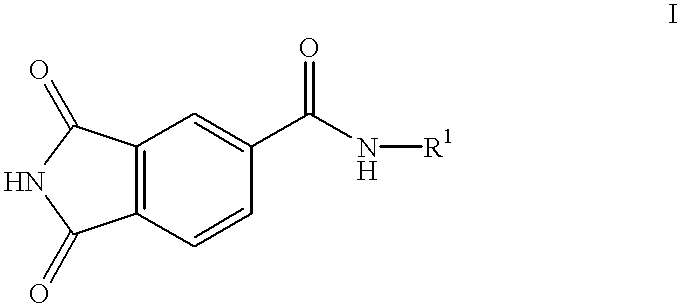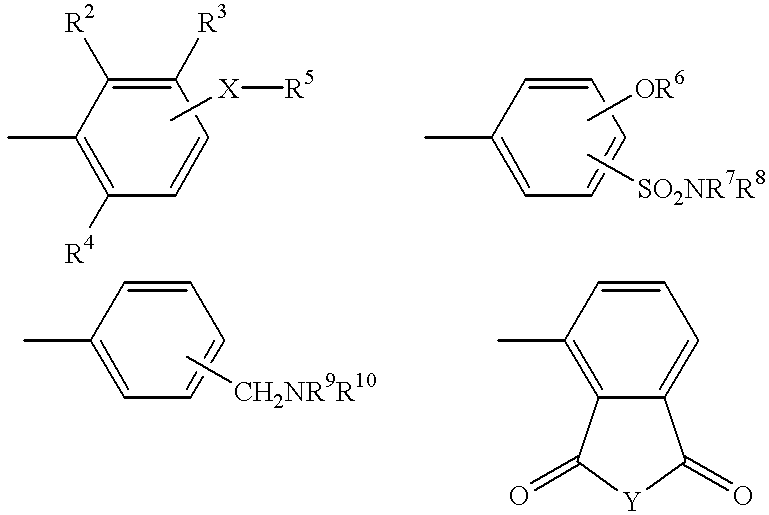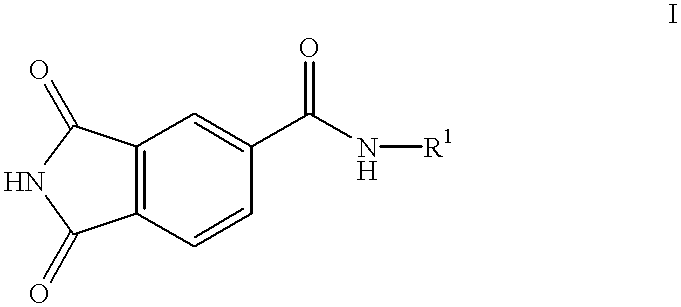Substituted 4-phthalimidocarboxanilides as inhibitors of purine salvage phosphoribosyltransferases
a phosphoribosyltransferase inhibitor and purine technology, applied in the direction of antiparasitic agents, biocides, drug compositions, etc., can solve the problems of large loss of beef production, difficult to prevent or remedy effectively, and widespread infection of parasitic protozoa in mammals
- Summary
- Abstract
- Description
- Claims
- Application Information
AI Technical Summary
Problems solved by technology
Method used
Image
Examples
example 1
Structure-Based Drug Design and Combinatorial Chemistry
A. Choice of Scaffold and Chemistry
The first step in inhibitor design involved scaffold modification. A good choice of a scaffold would lack any residual reactive functionalities, would be easily amenable to combinatorial modification, preferably in a solid phase format, and would not be associated with any known toxicities. Phthalimide appeared to fit all of these criteria. Nearly isosteric with phthalic anhydride, it presented an imide functionality suitable for attachment to the resin. A number of substituted phthalimides have been looked at as potential medicinal candidates, and had not been associated with any specific kind of toxicity. In addition, the imide portion of the molecule looks very similar to the C6-N1-C2 of xanthine, one of the natural substrates of HGXPRT. Since human HGPRT does not act on xanthine, the phthalimide scaffold could potentially have built-in selectivity for the parasite enzyme.
To test this hypoth...
example 2
Synthesis of 4-Carboxyphthalimide (2)
The title compound (2) was obtained, using commercially available trimellitic anhydride (1) as a starting material, by melting trimellitic anhydride with ammonium carbonate at 280.degree. C. as described in Aronov, et al., Tetrahedron Lett. 39:4947-4950 (1998). .sup.1 H NMR (DMSO-d.sub.6) .delta.7.93 (d, 1, H6), 8.07 (s, 1, H3), 8.14 (d, 1, H5).
example 3
Synthesis of N-Trityl-4-Carboxyphthalimide Resin (3)
To trityl chloride resin (5 g; 10.25 retool; 200-400 mesh: 1% divinylbenzene-crosslinked polystyrene) presoaked in 80 mL dry acetonitrile for 30 min., 5 g (26 mmol) 4-carboxyphthalimide (2) from Example 2 and 6 mL (34 mmol) DIPEA were added, and the suspension was refluxed for 72 h. Following filtration, the polymer was washed with 300 mL DMF and then 300 mL CH.sub.2 Cl.sub.2. The loading was determined by weight difference, and confirmed to be 0.5 mmol / g resin by TFA-induced cleavage of 4-carboxyphthalimide from the resin.
PUM
| Property | Measurement | Unit |
|---|---|---|
| Volume | aaaaa | aaaaa |
| Volume | aaaaa | aaaaa |
| Mass | aaaaa | aaaaa |
Abstract
Description
Claims
Application Information
 Login to View More
Login to View More - R&D
- Intellectual Property
- Life Sciences
- Materials
- Tech Scout
- Unparalleled Data Quality
- Higher Quality Content
- 60% Fewer Hallucinations
Browse by: Latest US Patents, China's latest patents, Technical Efficacy Thesaurus, Application Domain, Technology Topic, Popular Technical Reports.
© 2025 PatSnap. All rights reserved.Legal|Privacy policy|Modern Slavery Act Transparency Statement|Sitemap|About US| Contact US: help@patsnap.com



